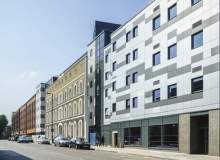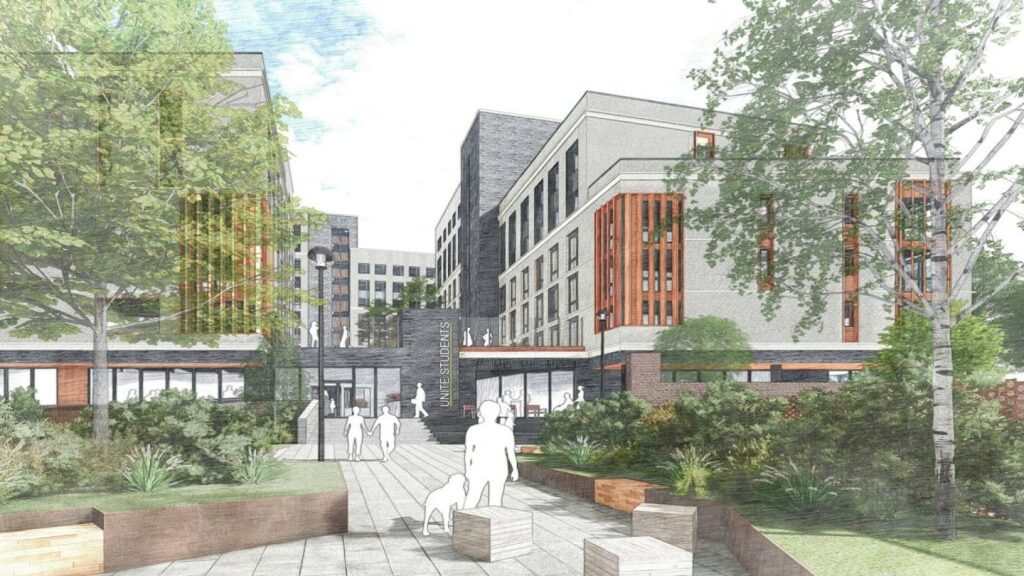

There was a time when student accommodation was epitomised by the squalor depicted in The Young Ones’ chaotic digs, but recent purpose-built designs have done their best to overthrow the shabby image of yesteryear’s lodgings. So it was regrettable that one particular example of architecture designed specifically for scholars was recently thrust into the limelight for all the wrong reasons.
UCL’s Carbuncle conundrum
The University of Central London’s (UCL) New Hall property at 465 Caledonian Road was the unfortunate recipient of this year’s Carbuncle Cup, an award run since 2006 by Building Design magazine to name and shame the worst building built in Britain in the previous 12 months. A very casual glance could make it seem like a tasteful conversion of a locally-listed 19th century warehouse, but it does not take exceptionally close examination before it reveals itself as, quite literally, just a façade.
Ellis Woodman, executive editor of Building Design, explains that the new scheme involved entirely demolishing the warehouse save for the front elevation, which is propped up around two metres forward of the new building.
"The reason they haven’t integrated the façade into the new building is they wanted to put in lower ceiling heights, so there’s a mismatch between the now windowless openings in the old façade and the windows of the elevation behind," says Woodman. "So when you’re in these rooms facing onto the street, many of them don’t have direct views out; you’re looking on to the back face of a brick wall."
See Also:
The mismatch doesn’t end there; because the new building at the back is significantly higher, the historic brickwork has been built up by another storey and the original pediments relocated back on top.
How well do you really know your competitors?
Access the most comprehensive Company Profiles on the market, powered by GlobalData. Save hours of research. Gain competitive edge.

Thank you!
Your download email will arrive shortly
Not ready to buy yet? Download a free sample
We are confident about the unique quality of our Company Profiles. However, we want you to make the most beneficial decision for your business, so we offer a free sample that you can download by submitting the below form
By GlobalDataBut it wasn’t just that egregious way of treating a bit of listed architecture that outraged Building Design’s panel of columnists; New Hall also provides a sub-standard interior environment to the students.
"The building is incredibly high-density around a courtyard which consists of nine or ten storeys on the south edge with overlooking distances of around five metres from the window from one room to the next," says Woodman. "There’s very poor daylight provision, close overlooking and all of these issues were enough for the local authority to throw out the proposal when it was initially submitted for planning."
Despite this, the construction went ahead because the developer appealed to the planning inspectorate who after consideration recognised the failings, but conceded that because it was student accommodation, the same standards need not apply as for conventional housing. This is because the resident students would be there for a short period of their lives, and they should theoretically be out on campus for much of the day so don’t require the same statutory protection as an average occupant.
Stirling achievement for Limerick
At the more admirable end of the scale, the scheme designed by Grafton Architects on the University of Limerick campus was shortlisted for this year’s Royal Institute of British Architects’ (RIBA) Stirling prize for excellence in architecture. The new blocks, adjacent to a new medical school also built by Grafton, are described by RIBA as "two muscular buildings that despite their modest size convey a sense of scale and weight in creating a point of entry to the campus."
"They’ve succeeded in making a place with these buildings where there’s an urban ambition; it’s not just a case of providing battery conditions for students," says Woodman. "The provision of shared spaces is very strong; it’s a rather monumental series of brick buildings that have a very nice scale."
While student accommodation often results in a series of homogeneous buildings with a frontage indistinguishable from a low-budget hotel, Woodman says there is an ingenuity to the way the Limerick buildings have been designed.
"The elevations of the buildings have ingeniously clustered windows together to make fewer but larger openings," he says. "So although the buildings are bigger than a house, they have a house-like quality because they have eight or nine large openings rather than 30 very small ones."
Targeting out-of-term conference trade
While grand designs win awards, they risk going beyond the budget of the average university to build, and the typical student to rent. However, by going up-market, the buildings can help pay for themselves out of term-time by being used by the conference trade.
One enterprise using that model is Student Castle, a business founded in 2010 under CEO Edward Cade and supported by Sir Charles Dunstone and Roger Taylor, chairman and CEO respectively of the Carphone Warehouse/Talk Talk groups. The high-end housing incorporates new-build favourites like oak laminate floors and Duravit bathrooms.
In Manchester, Hodder+Partners, the company run by current president of RIBA Stephen Hodder, is building a new 600 bed student residence adjacent to Manchester University.
"They saw a huge shortage of custom designed student accommodation in Manchester, even though much of the student population is renting in existing houses," says Woodman. "I don’t think all their projects are that ambitious, but an interesting building has resulted."
However, the UK may not yet be ready to fully embrace the radical Dutch solution to the problem of insufficient student accommodation in Amsterdam. To save space and resources, the company Tempohousing has built Keetwonen, the world’s biggest city constructed using shipping containers. Far from a second-rate solution, the container units turned out to be spacious, quiet and well insulated and offer good value for money compared with existing accommodation.
Overseas students drive building expansion
While many of these new builds are easy on the eye and attractive to students seeking a better standard of living than traditional digs, with many units in London starting at £250 a week, they are beyond the budget of average UK students and their overstretched families. In many cases they are mostly rented by overseas students.
"It’s mainly the overseas market that is largely responsible for this huge escalation in student numbers that we’re seeing at the moment, perhaps somewhat unexpectedly given the fees situation," says Woodman. "But in particular the foreign students are pushing universities into some sort of building expansion at the moment."
This has been supported by a recent relaxation in the ways universities can raise funds for capital projects; they can now borrow against their existing estate in a way that they couldn’t up until last year.
"The LSE is finishing its student centre this month, there’s another £90 million project that’s out to competition at the moment, then another one on Lincoln’s Inn Fields of similar size to follow," says Woodman. "I think you’ll find the next ten years will be a rather energetic period of construction for many of the universities, especially in that second-tier group."
Tower blocks shoot skywards
But with real estate in cities like London at a premium, perhaps the biggest trend in student new build is upwards.
"There’s an increasing incidence of towers; there’s one that’s just gone up at Kings Cross," says Woodman, referring to the Urbanest project.
But however small a footprint university accommodation takes up, attempts to build in cities will always be a source of conflict with local authorities, which are averse to student housing because the occupants do not contribute to local council tax. They also take up sites that could be used for much-needed permanent housing for tax-paying residents.
Either way, this particular golden era of student accommodation could be coming to a close as the financial downturn begins an upswing.
"During the downturn when the housing market was slow, a lot of sites that would have become housing projects were developed as student housing and hotels," says Woodman. "Given the state of the London property market I can imagine there’s more impetus to develop them as commercial housing schemes."
It could consequently be students’ last chance to indulge in a few years languishing in purpose-built designer accommodation with all mod cons, before the inevitable return to washing-up rotas and labelling a lone sausage in the fridge to keep it from thieving hands.
Follow Berenice Baker on Google+
Related content
Top ten tallest skyscrapers in the world
The appetite for tall skyscrapers is especially significant in China, which currently houses four of the world’s tallest buildings.
Vertical village: the future of high-rise living
The vertical village concept offers a vibrant alternative to drab and dreary residential tower blocks.







